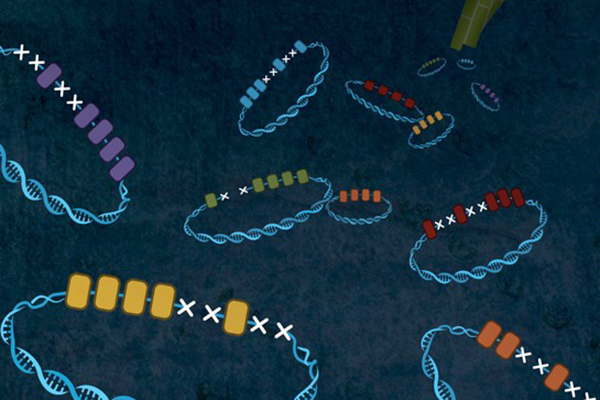
Image: Alt lab
The genome of developing brain cells harbors 27 clusters, or hotspots, where its DNA is much more likely to break in some places than others, according to research from Harvard Medical School and Boston Children’s Hospital.
Those hotspots appear in genes associated with brain tumors and a number of neurodevelopmental and neuropsychiatric conditions.
The findings, reported Feb. 11 in Cell, raise new questions about the origins of these conditions as well as how the brain generates a diversity of circuitry during development.
The study’s roots reach back more than 30 years, when study senior author Frederick Alt, the HMS Charles A. Janeway Professor of Pediatrics and director of the Program in Cellular and Molecular Medicine at Boston Children’s, and his colleagues first started investigating the links between tumors, oncogenes, DNA breaks and DNA repair, particularly in immune and nerve cells.
Over the course of several studies, Alt’s lab discovered that nerve cells lacking one particular DNA repair pathway called non-homologous end joining, which cannot repair breaks in their DNA strands, either die off early in development or give rise to brain tumors called medulloblastomas.
However, Alt’s lab and others have struggled to understand why the loss of this pathway would have such dramatic effects.
“We’ve thought a lot about DNA breaks,” said Alt, who is also a professor of genetics at HMS. “Many people over the years have considered the possibility that DNA breaks could be important for generating diversity in neural development. But nobody has had a way to identify the breaks in neural cells that would lead to this almost complete block of nervous system development in the absence of non-homologous end joining.”
In recent years, Alt’s lab engineered a method for mapping DNA breaks throughout the genome at very fine resolution, called high-throughput genome-wide translocation sequencing.
Alt has also used this method, which was initially developed to understand how genes reshuffle or translocate in cancer, to measure the precision of CRISPR gene editing and to probe how the genome prevents DNA-snipping enzymes from cutting genes in places they shouldn’t.
In the current study, Alt lab members and colleagues used high-throughput genome-wide translocation sequencing and informatics techniques to search for and map DNA break patterns in mouse neural stem and progenitor cells (NSPCs, cells that produce the brain’s neurons, astrocytes and oligodendrocytes) under conditions of replication stress.
The experiments revealed 27 clear, recurring hotspots where the NSPC genomes break frequently. Strikingly, those 27 break hotspots were all spread across the bodies of 27 individual genes.
Those genes shared a number of characteristics.
All were long, mostly more than 100 kilobases, with multiple exons (coding segments) and long introns (non-coding segments).
Most were late replicators, meaning they were copied late in the cell division process.
They encoded proteins found on the surface of neurons that mostly perform functions that help neurons communicate (e.g., synapse formation, cell-cell adhesion).
And 24 of the 27 genes have been linked to tumor suppression and/or neurological conditions such as autism spectrum disorder, schizophrenia and bipolar disorder.
“In our dreams, we couldn’t have found a set of genes to better fit the hypothesis that breaking DNA in neural cells is important,” Alt said.
The breaks the team identified appeared most frequently in the genes’ introns, leading the team to speculate that the hotspots might have a distinct purpose: to help the brain generate a diverse repertoire of circuitry.
“Because the breaks occur mostly between exons, they would likely, in some cases, cause an exon or two to be deleted and potentially allow the gene to produce a different protein,” Alt explained.
By splicing genes’ exons in different ways, the genome could generate several variations of the proteins the genes encode. The neurons that develop from the NPSCs could then wire themselves into unique neural circuits.
“The protein encoded by one of the genes we identified, neurexin, potentially has more than 1,000 different forms, some of which may make connections between neurons of different strengths,” said Pei-Chi Wei, a postdoctoral fellow in the Alt lab. “What we found could provide a mechanism for making a diversity of synaptic connections and make contacts between neurons different.”
“During neural development, you generate a whole brain, with some 100 billion neurons, from a relatively limited number of NSPCs,” added Bjoern Schwer, HMS assistant professor of pediatrics in the Alt lab. “In this context, is there a potential advantage to having recurrent DNA breaks? It could be a way to sample different combinations of circuits and synapses, almost like evolution in miniature.
“We don’t know for sure that this is the case,” he continued, “but we now show that these replication stress-associated breaks that occur during neural development could be a way to contribute to the perceived diversity of neural cells that end up in the mature brain.”
The team also speculates, based on their findings, that replication stress-associated DNA damage during neural development could, by affecting these genes, promote neurodevelopmental or neuropsychiatric diseases.
“Virtually all of these genes have been associated with diseases that have a neurodevelopmental component,” said Schwer. “It could be that when you can’t efficiently repair breaks within genes, it could predispose the individual to neurodevelopmental disease.”
Amelia Chang, a graduate student in the Alt lab, was an additional author on the paper.
The study was supported by the Howard Hughes Medical Institute, National Institute on Aging (grant K01AG043630), the V Foundation for Cancer Research, a National Cancer Center postdoctoral fellowship and the Porter Anderson Fund at Boston Children’s Hospital. Alt is a Howard Hughes Medical Institute Investigator.
Adapted from a Boston Children’s news release.


